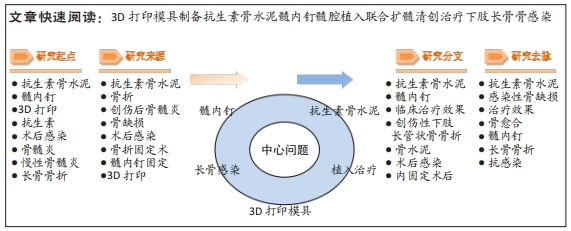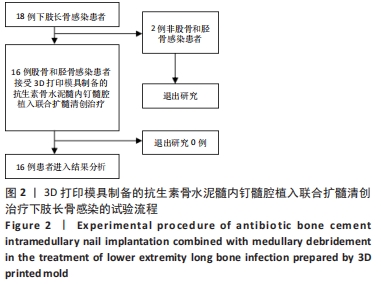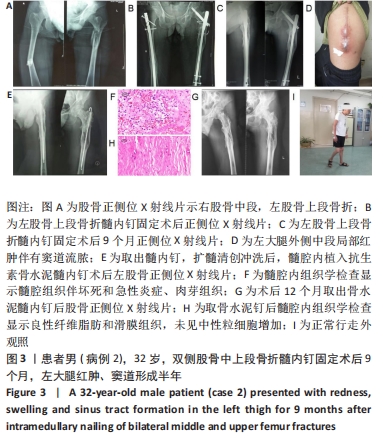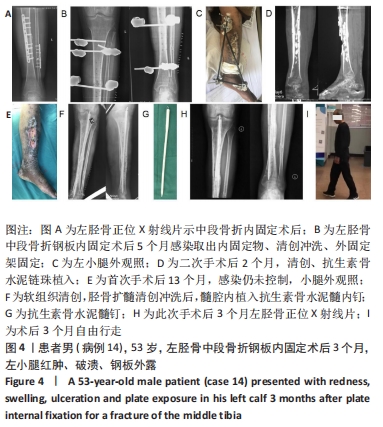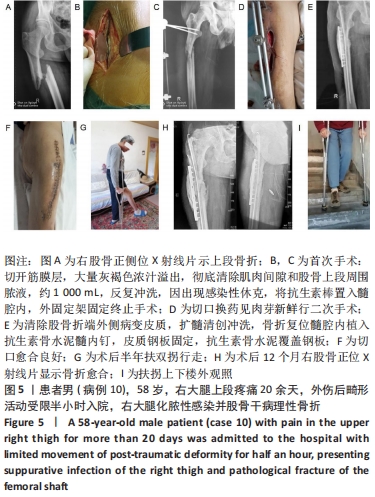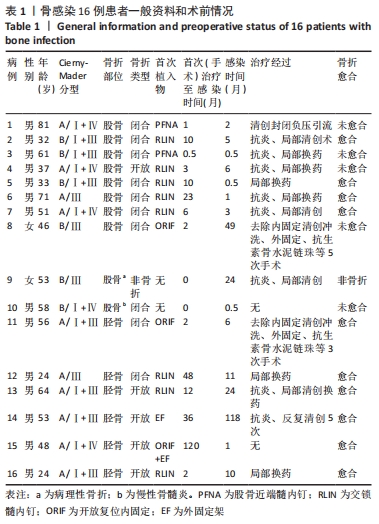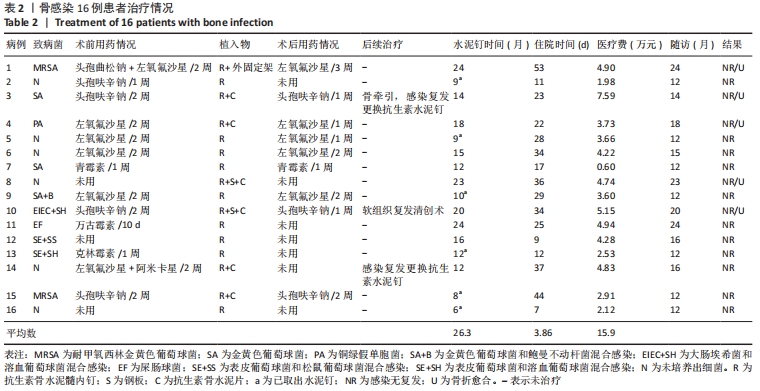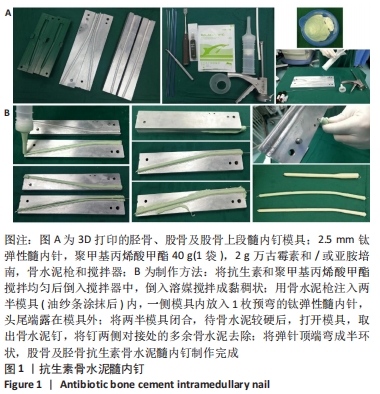[1] METSEMAKERS WJ, EMANUEL N, COHEN O, et al. A doxycycline-loaded polymer-lipid encapsulation matrix coating for the prevention of implant-related osteomyelitis due to doxycycline-resistant methicillin-resistant Staphylococcus aureus. J Control Release. 2015; 209:47-56.
[2] YOUNG S, LIE SA, HALLAN G, et al. Risk factors for infection after 46,113 intramedullary nail operations in low- and middle-income countries. World J Surg. 2013;37(2):349-355.
[3] DOSHI P, GOPALAN H, SPRAGUE S, et al. Incidence of infection following internal fixation of open and closed tibia fractures in India (INFINITI): a multi-centre observational cohort study. BMC Musculoskelet Disord. 2017;18(1):156.
[4] MAKRIDIS KG, TOSOUNIDIS T, GIANNOUDIS PV. Management of infection after intramedullary nailing of long bone fractures: treatment protocols and outcomes. Open Orthop J. 2013;7:219-226.
[5] HAKE ME, OH JK, KIM JW, et al. Difficulties and challenges to diagnose and treat post-traumatic long bone osteomyelitis. Eur J Orthop Surg Traumatol. 2015;25(1):1-3.
[6] SANCINETO CF, BARLA JD. Treatment of long bone osteomyelitis with a mechanically stable intramedullar antibiotic dispenser: nineteen consecutive cases with a minimum of 12 months follow-up. J Trauma. 2008;65(6):1416-1420.
[7] SANDERS J, MAUFFREY C. Long bone osteomyelitis in adults: fundamental concepts and current techniques. Orthopedics. 2013; 36(5):368-375.
[8] LIDGREN L, TÖRHOLM C. Intramedullary reaming in chronic diaphyseal osteomyelitis: a preliminary report. Clin Orthop Relat Res. 1980;(151): 215-221.
[9] ZALAVRAS CG, SINGH A, PATZAKIS MJ. Novel technique for medullary canal débridement in tibia and femur osteomyelitis. Clin Orthop Relat Res. 2007;461:31-34.
[10] TOSOUNIDIS TH, CALORI GM, GIANNOUDIS PV. The use of Reamer-irrigator-aspirator in the management of long bone osteomyelitis: an update. Eur J Trauma Emerg Surg. 2016;42(4):417-423.
[11] KANAKARIS N, GUDIPATI S, TOSOUNIDIS T, et al. The treatment of intramedullary osteomyelitis of the femur and tibia using the Reamer-Irrigator-Aspirator system and antibiotic cement rods. Bone Joint J. 2014;96-B(6):783-788.
[12] ZIMMERLI W, SENDI P. Orthopaedic biofilm infections. APMIS. 2017; 125(4):353-364.
[13] ARCIOLA CR, CAMPOCCIA D, MONTANARO L. Implant infections: adhesion, biofilm formation and immune evasion. Nat Rev Microbiol. 2018;16(7):397-409.
[14] 郑强,潘志军,李杭,等.抗生素骨水泥棒治疗交锁钉术后髓内感染[J].中华创伤杂志,2007,23(4):265-267.
[15] KLEMM K, HENRY SL, SELIGSON D. The treatment of infection after interlocking nailing. Techniques Orthop.1988;3(3):54-61.
[16] PALEY D, HERZENBERG JE. Intramedullary infections treated with antibiotic cement rods: preliminary results in nine cases. J Orthop Trauma. 2002;16(10):723-729.
[17] CONWAY J, MANSOUR J, KOTZE K, et al. Antibiotic cement-coated rods: an effective treatment for infected long bones and prosthetic joint nonunions. Bone Joint J. 2014;96-B(10):1349-1354.
[18] QIANG Z, JUN PZ, JIE XJ, et al. Use of antibiotic cement rod to treat intramedullary infection after nailing: preliminary study in 19 patients. Arch Orthop Trauma Surg. 2007;127(10):945-951.
[19] BHADRA AK, ROBERTS CS. Indications for antibiotic cement nails. J Orthop Trauma. 2009;23(5 Suppl):S26-30.
[20] SELHI HS, MAHINDRA P, YAMIN M, et al. Outcome in patients with an infected nonunion of the long bones treated with a reinforced antibiotic bone cement rod. J Orthop Trauma. 2012;26(3):184-188.
[21] WASKO MK, BORENS O. Antibiotic cement nail for the treatment of posttraumatic intramedullary infections of the tibia: midterm results in 10 cases. Injury. 2013;44(8):1057-1060.
[22] WASKO MK, KAMINSKI R. Custom-Made Antibiotic Cement Nails in Orthopaedic Trauma: Review of Outcomes, New Approaches, and Perspectives. Biomed Res Int. 2015;2015:387186.
[23] HAKE ME, YOUNG H, HAK DJ, et al. Local antibiotic therapy strategies in orthopaedic trauma: Practical tips and tricks and review of the literature. Injury. 2015;46(8):1447-1456.
[24] REILLY RM, ROBERTSON T, O’TOOLE RV, et al. Are antibiotic nails effective in the treatment of infected tibial fractures? Injury. 2016; 47(12):2809-2815.
[25] CHO JW, KIM J, CHO WT, et al. Antibiotic coated hinged threaded rods in the treatment of infected nonunions and intramedullary long bone infections. Injury. 2018;49(10):1912-1921.
[26] 薛德挺,李杭,潘志军,等.下肢长骨骨折髓内钉固定术后早期和迟发骨感染的处理[J].中华骨科杂志,2018,38(9):556-562.
[27] FINELLI CA, DOS REIS FB, FERNANDES HA, et al. Intramedullary reaming modality for management of postoperative long bone infection: a prospective randomized controlled trial in 44 patients. Patient Saf Surg. 2019;13:39.
[28] 王上增.抗生素骨水泥间置器治疗髓内固定术后骨髓炎合并骨不连[J].中国修复重建外科杂志,2011,25(8):972-975.
[29] THONSE R, CONWAY J. Antibiotic cement-coated interlocking nail for the treatment of infected nonunions and segmental bone defects. J Orthop Trauma. 2007;21(4):258-268.
[30] THONSE R, CONWAY JD. Antibiotic cement-coated nails for the treatment of infected nonunions and segmental bone defects. J Bone Joint Surg Am. 2008;90 Suppl 4:163-174.
[31] NOH JH, KOH SJ, LEE KH. Treatment of Proximal Femur Osteomyelitis Occurred after Proximal Femoral Nail Antirotation Fixation, with Antibiotic Cement-coated Tibia Intramedullary Nail: A Case Report. Hip Pelvis. 2018;30(1):45-52.
[32] SHYAM AK, SANCHETI PK, PATEL SK, et al. Use of antibiotic cement-impregnated intramedullary nail in treatment of infected non-union of long bones. Indian J Orthop. 2009;43(4):396-402.
[33] 张彦龙,冯晨晨,田书伟,等.扩髓清创联合抗生素骨水泥髓腔植入治疗髓内钉术后感染[J].中华骨科杂志,2018,38(9):523-529.
[34] CIERNY G 3RD, MADER JT, PENNINCK JJ. A clinical staging system for adult osteomyelitis. Clin Orthop Relat Res. 2003;(414):7-24.
[35] KIM JW, CUELLAR DO, HAO J, et al. Custom-made antibiotic cement nails: a comparative study of different fabrication techniques. Injury. 2014;45(8):1179-1184.
[36] PENNER MJ, MASRI BA, DUNCAN CP. Elution characteristics of vancomycin and tobramycin combined in acrylic bone-cement. J Arthroplasty. 1996;11(8):939-944.
[37] JIANG N, WU HT, LIN QR, et al. Direct healthcare costs and utilization for inpatiets with extremity post-traumatic osteomyelitis:a retrospective single-center observational study in Southern China. Helsinkin, Finland: 37th Annual Meeting of the European Bone and Joint Infection Society, 2018.
|
